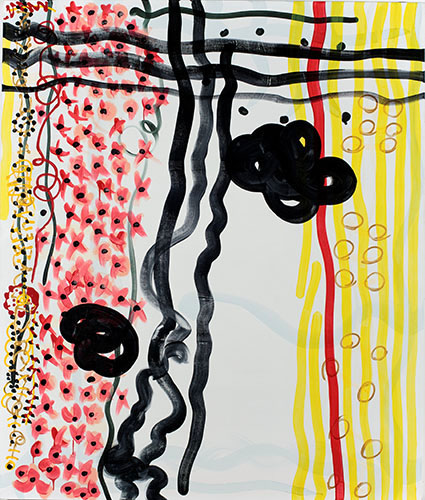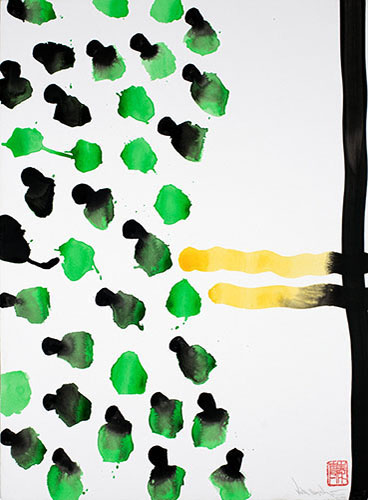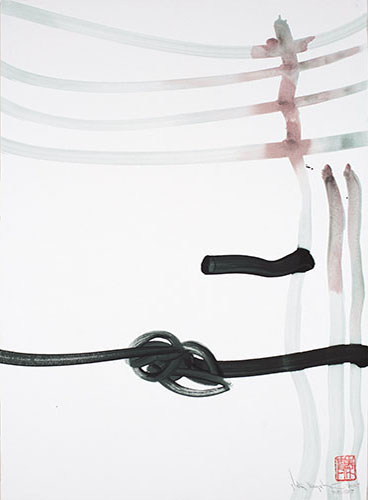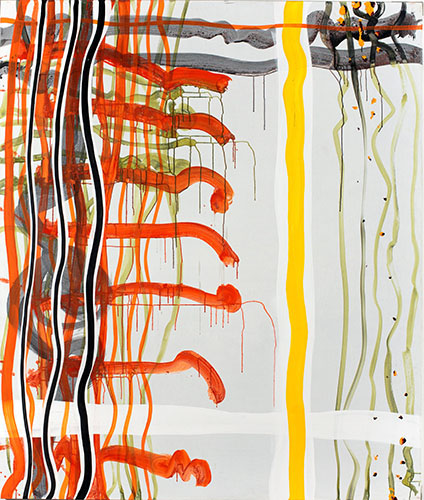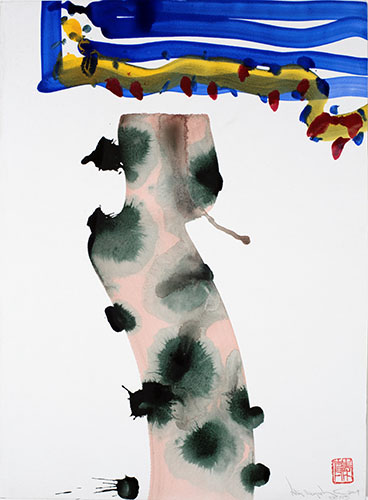Peter Wayne Lewis @ JAYJAY
Posted on 08 December 2011
The relationship between jazz and abstract painting is longstanding. The infatuation began in the ’20s, when European Modernists embraced New Orleans jazz and Swing and then blossomed at mid-century when Abstract Expressionists fell head-over-heels for Bebop. That the affair continues, unabated and global, testifies to the potency of cross-disciplinary influences. No other art form has had as strong an influence on painting as jazz.
Which is why, when I learned about Peter Wayne Lewis, my antennae went up. He, too, claims a connection between jazz and painting, and, at times, he comes credibly close to making it concrete. It happens in loose, wide-open gestural paintings whose form, substance and structure hew to the same principles that govern jazz: namely, elastic expression within set structures. For the chord progressions of jazz Lewis substitutes wavy geometric grids, some visible, others implied. These he creates with brush-painted lines whose squiggly contours recall Sumi ink painting, both in their gradations of luminosity and in their balance of spontaneity and precise control, the latter exemplified in the arabesques he spins with a wrist flick in the middle or at the end of long flowing lines. Using the same technique, he also peppers his canvases with small paint dabs that have the upturned-nipple shape of chocolate “kisses”. There are also in his works highly diluted stains like those seen in Asian watercolors. In his modulation of these elements, Lewis proves himself a master of rhythm, a kind of off-kilter rhythm, achieved through bodily intuition, not careful plotting. Like the skittering grooves of Thelonius Monk which, by themselves, would have little context or impact without accompaniment, it’s the edges of the canvas that contain Lewis’ fluid compositions and give them coherence. In pictures ranging in size from 30 x 22 inches to 7 x 6 feet, he skirts representation almost entirely, a rare thing in abstract painting no matter what the method or intent.
Beijing Booster 601, the boldest of the large paintings, has a gushing, roiling celebratory quality; it unfurls before the eye like a ticker-tape parade revealed in paint. Working at smaller scales, as in Beijing Booster 513, Lewis allows oozing biomorphic forms to stand almost naked.
A Jamaican-American who emigrated to Sacramento in 1962 and then moved to New York after earning an MA in art at San Jose State, Lewis, 58, leads a peripatetic existence that rivals that of any globe circumnavigating musician. He divides his time between a home in South Orange, N.J., a job in Boston teaching painting at the Massachusetts College of Art and a studio in Beijing. Contrary to what you might imagine, the latter has not darkened his sunny pallete or injected politics into his work. Lewis mostly remains tethered to his own history, and, more than anything else, to his own psycho-motor impulses, some of which may be genetically encoded: His father was an accomplished jazz pianist; his grandparents were missionaries. His friends include the jazz-influenced poet Amiri Baraka, as well as many New York-area musicians.
Like the jazz legends who recorded for Blue Note, Prestige and Impulse at Rudy Van Gelder’s studio in nearby Englewood Cliffs, N.J., Lewis completes all of his works in a single take without revision. He titles and numbers them sequentially. What you see is an exact record of how each painting was made. Thus, any “holes” in a series correspond to paintings the artist rejected rather than rework. The downside to this “first-thought, best-thought” approach is that some paintings feel underdeveloped and, at times a bit glib, as if the artist tossed them off a little too quickly. The counterargument made by the exhibition is that the smaller paintings are designed to be seen in series, and it’s a valid point: In trios, they generate a certain interactive spark.
Lewis is fond of citing Coltrane and Ellington as inspirations. I see a more accurate (and far less dense analog) in guitarist Bill Frisell, a minimalist who says as much with “active” empty space as he does with actual played notes. Lewis does the same thing with well-aimed gestures and lots of white space. What we get in these light-drenched, tropically colored paintings are works that invite viewers “inside” without demanding a big down payment in visual literacy – or a large investment in decoding arcane iconographies. In jazz, they call it accessibility. In visual art it’s called Pop. Or, in Lewis’ case, you might call it a kind of Minimalist/Pop/Abstraction – one that reflects historical antecedents, but isn’t weighed down by them.
–DAVID M. ROTH
# # #
Peter Wayne Lewis: “Paintings from Middle Earth” @ JAYJAY through Dec. 23, 2011.
About the author:
David M. Roth is the editor and publisher of Squarecylinder. A veteran journalist, he is a former contributing editor at Artweek and a critic for Art Ltd.

